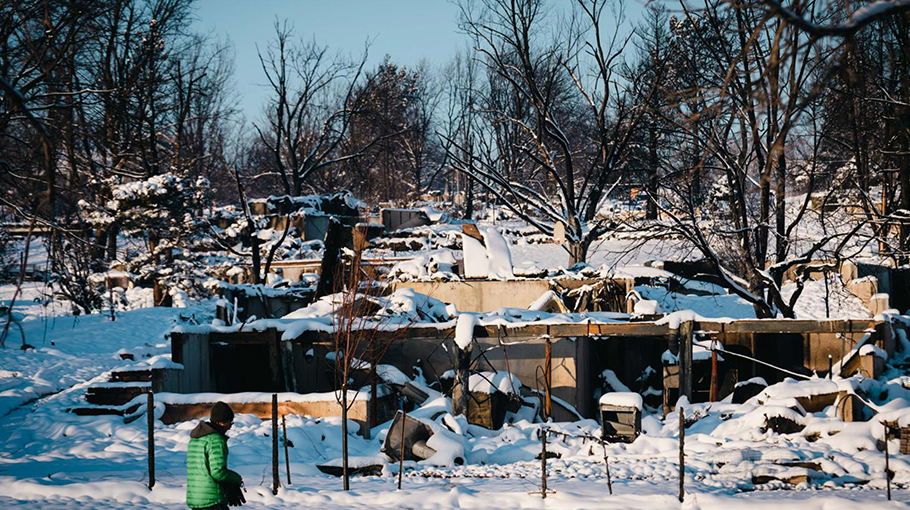Colorado residents ponder the road ahead after wildfires


Ms Kathe Perez can barely process what she lost in the incineration of the three-bedroom home she's lived in for the past three decades.
"I haven't slept for three nights," she said Sunday (Jan 2). "I can't stop crying. I can't talk. I feel in a daze. My soul is crushed." And yet, when she looks to the future, she sees only one option. "I have high optimism," she said. "Everyone says you can't imagine this happening to you. But when it's right in front of you, we're built for this. You can only do the next thing. But first, rebuild it."
Her home is one of more than two dozen in her neighbourhood in Louisville destroyed by the devastating Marshall fire, which consumed roughly 1,000 homes in suburban neighbourhoods between Denver and Boulder on Thursday.
And after the flames, after charred homes were buried under snow Saturday, people turned Sunday to the daunting task of imagining the long road back to the life they took for granted before the fire.
"Just a few days ago, you were celebrating Christmas at home, and hanging your stockings, and now home and hearth have been destroyed," Colorado's governor Jared Polis said at a news conference Sunday. "It's a shock." Whole neighbourhoods turned to ash, while local stores, including a Tesla dealership, were destroyed or badly damaged in what might turn out to be the most damaging wildfire in state history.
At a moment's notice, 35,000 people were forced to evacuate as nearly 1,000 homes were set ablaze. Shortly thereafter, the state received a baffling 10 inches (25cm) of snow on land the wildfire had scorched.The death toll remains at zero, but two people are still missing, Sheriff Joe Pelle of Boulder County said Sunday. The search team is now checking incinerated homes for any human remains. The cause of the fire remains unconfirmed. "I don't have a definitive or final answer for you yet," Mr Pelle said at a second news conference Sunday. "And I don't want to go down rabbit holes, as far as speculation."
Officials from the Federal Emergency Management Agency arrived Sunday, while a disaster assistance centre opened in the area for those returned to homes still intact but without power. Even the local post office performed a small miracle: Mail delivered on a Sunday.
"It's a long road ahead," Mr Polis said. "We've built back from other disasters, and we will build back stronger from this one."
Ms Perez and her neighbours have formed a private Facebook group to share information, and most group members are expressing their intent to rebuild, she said.
But in a time of shortages of labour and resources, and in the middle of a pandemic, there are enormous financial and logistical hurdles that she, and others, now face in constructing new homes. While Ms Perez is insured, she isn't sure she can afford this. "I'm told it would cost US$800,000 (S$1.08 million) now," she said. "My policy is not an US$800,000 policy."
Mr Garry Sanfa, the county's disaster recovery manager, said recovery from these kinds of disasters is measured not in months, but in years.
The state isn't even done, he pointed out, rebuilding from a disastrous flood that hit the area nine years ago.
And while wildfires usually occur in Colorado's mountainous region, far from where most of its residents live, the Marshall fire attacked drought-stricken suburban neighbourhoods instead.
Only about 100 of the nearly 1,000 homes burned by the 6,200acre (2,500ha) wildfire were on unincorporated land, according to Mr Sanfa. The rarity of this event means recovery reliefs are entering uncharted territory.
And although about 60 per cent of people who live in homes damaged in mountainous areas are uninsured, according to Mr Sanfa, it may be different for suburban homeowners.
Officials will also need to process the exhaustive paperwork involved in rebuilding, and as people start to rebuild on their charred properties, he isn't sure how competition for contractors and building supplies will play out.
"This is not an infrastructure disaster," he said. "This is a private property disaster."
While many of the homes destroyed by the fire were owned by people who are considered affluent, Dr Lori Peek, a sociology professor and the director of the Natural Hazards Center at the University of Colorado Boulder, said there are also renters in the region.
"There are people who are going to be underinsured," she said. "We for sure know that."
As Dr Peek points out, disasters are a shared experience, but not everyone exists on the same financial plane.
"The fact of the matter is that in those disasters, inequities always emerge in terms of who is most impacted and who has the hardest time recovering from disastrous events," Dr Peek said.
And while Ms Perez waits to find out what rebuilding her home will look like, she continues to ride a wave of emotions that range from despair to confusion to hope. "I have to find a place to live," she said. "And then face whatever comes next."


